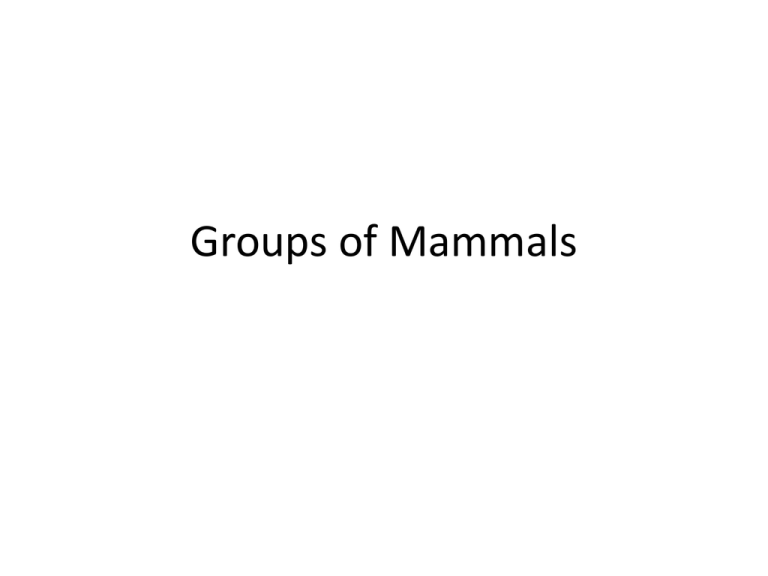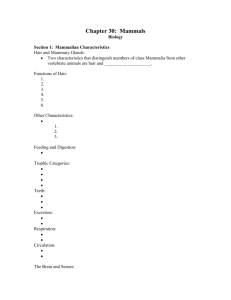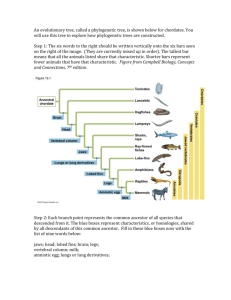Groups of Mammals
advertisement

Groups of Mammals Classification of Mammals • Mammals range in size from a tiny shrew (1.5 grams) to a blue whale (150 tons) • Mammals inhabit more environment than any other vertebrates • Modern mammals are classified into three groups – Monotremes – Marsupials – Placental Mammals Monotremes • Monotremes are a small group of organisms found only in Australia and New Guinea • Monotremes share more traits with reptiles than with other mammals. • Monotremes are the only living mammals that lay eggs Monotremes are similar to reptiles because… • Monotremes have legs that sprawl to the side instead of being under the body • Monotremes are the only mammals to have a cloaca – A common passage way for the digestive, reproductive and urinary systems • Adult monotremes DO NOT have teeth Monotremes are like other mammals because… • Monotremes have hair • Monotremes produce milk to feed their young – However, female monotremes DO NOT have nipples – Young drink milk that oozes from glands that are located on their mother’s belly Marsupials • Marsupials include: Wombats, Koalas, and opossums • Females of most marsupials have a pouch, and their young spend most of their time developing inside the pouch while they nurse and grow Marsupials • Marsupials are the most diverse mammals in Australia – Marsupials are also found in South America and North America Marsupials • The habitats and lifestyles of marsupials in Australia, New Zealand, and nearby islands are similar to those of placental mammals • Examples: – Kangaroos and Wallabies often live in large groups like deer (a placental mammal) – Tree kangaroos are similar to monkeys because both can climb – Gliders and possums are similar in habits to squirrels Placental Mammals • Cats, dogs, cows, horses, and humans are placental mammals • Placental mammals make up nearly 95% of all mammal species • The young of placental mammals develop inside the female’s uterus – Here they are nourished by nutrients from her blood Placental Mammals • Placental Mammals have a longer period of internal development than marsupials • Placental Mammals are more developed at birth than the young of marsupials • There are many types of placental mammals, which vary greatly in size, shape, diet and habits Domestic Mammals • Domestic Mammals are animals that have been kept and bred by people for special purposes • Domestic Mammals may provide work, food, clothing, or companionship • Most Domestic Mammals are placental mammals whose association with humans dates back up to 15,000 years Domestic Mammals • Domestic Mammals include: dogs, cats, cattle, horses, donkeys, mules, rabbits, sheep, goats, pigs, camels, llamas, and alpacas How Domestic Mammals are Made • Various breeds of domestic mammals have been developed through selective breeding – Example: Some breeds of goat produce more milk than others • Some domestic mammals are hybrids of two species – Example: Mules are formed from a female horse and male donkey






